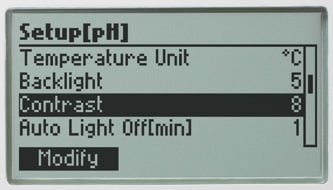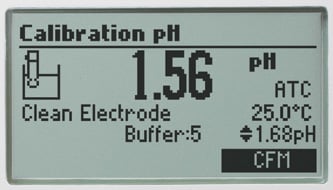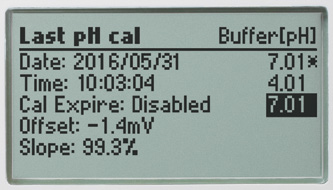
Digital Refractometer for % Brix, °Oe and °KMW Sugar Analysis in Wine, Juice and Must
The HI96814 is a rugged, portable digital refractometer designed for sugar (% Brix, °Oe and °KMW) measurement of wine, juice and must. The HI96814 has a high accuracy of ±0.2% Brix, ±1°Oe and ±0.2°KMW. All readings are automatically compensated for temperature variations according to the ICUMSA Methods Book standard and displayed with a 1.5 second response time. The sealed flint glass prism and stainless steel well are easy to clean. Just wipe with a soft cloth in preparation for the next sample.
- Sample size as small as 2 metric drops (100 μll)
- Sealed stainless steel well with high-grade optical prism made of flint glass
- Fast 1.5 second response time for temperature compensated readings
The measurement of pH in milk is important in testing for impurities, spoilage, and signs of mastitis infection. While there are a number of factors that affect the composition of milk, pH measurements can help producers understand what might be causing certain compositional changes. pH measurement is commonly performed at various points in a milk processing plant.
Fresh milk has a pH value of 6.7. When the pH value of the milk falls below pH 6.7, it typically indicates spoilage by bacterial degradation. Bacteria from the family of Lactobacillaceae are lactic acid bacteria (LAB) responsible for the breakdown of the lactose in milk to form lactic acid. Eventually when the milk reaches an acidic enough pH, coagulation or curdling will occur along with the characteristic smell and taste of sour milk.
Milk with pH values higher than pH 6.7 potentially indicate that the milk may have come from cows with a mastitis infection. Mastitis is an ever-present challenge with dairy milking cows. When infected, the cow's immune system releases histamine and other compounds in response to the infection. There is a resulting increase in permeability of endothelial and epithelial cell layers, allowing blood components to pass through a paracellular pathway. Since blood plasma is slightly alkaline, the resulting pH of milk will be higher than normal. Typically milk producers can perform a somatic cell count to detect a mastitis infection, but a pH measurement offers a quick way to screen for infection.
Understanding the pH of raw milk can also help producers optimize their processing techniques. For example, in operations that use Ultra High Temperature (UHT) processing, even small variations from pH 6.7 can affect the time required for pasteurization and the stability of the milk after treatment.
Measuring the pH of milk can provide a number of challenges. Milk products tend to have a high solids content that will coat the sensitive glass membrane surface and/or clog the reference junction. The FC1013 supplied with the HI98162 is specifically designed for measuring pH in milk. The Polyvinylidene fluoride (PVDF) body is a food grade plastic that is resistant to most chemicals and solvents, including sodium hypochlorite. It has high abrasion resistance, mechanical strength and resistance to ultraviolet and nuclear radiation. PVDF is also resistant to fungal growth. The FC1013 is an ideal general-purpose pH electrode for milk products that connects to the HI98162 with a quick-connect, waterproof DIN connector, allowing for a secure, non-threaded attachment.
![]() This pH meter meets the FDA Food Safety Modernization Act (FSMA) compliance standards.
This pH meter meets the FDA Food Safety Modernization Act (FSMA) compliance standards.

The HI98162 uses the FC1013 amplified pH electrode with PVDF body. This specialized electrode offers numerous features that improve pH testing for milk producers. An integrated temperature sensor allows for temperature compensated pH measurements without the need for a separate temperature probe. The contact between the bulb™s large surface area and the milk sample ensures a stable calibration and measurement.
An integral part of any pH electrode is the reference junction. The reference junction is a part of the electrode that allows for the flow of ions located in the reference cell into the sample being tested. It is vital that this flow occurs in order to complete an electrical circuit, which ultimately determines the pH value. Any clogging of the junction will prevent completion of the circuit, resulting in readings that are erratic or constantly drifting.
The FC1013 probe utilizes a secondary reference chamber with ceramic outer junction allowing aqueous silver free electrolyte to flow slowly through the porous ceramic frit providing accurate readings for aqueous samples.
The durable PVDF body of the FC1013 ensures pH measurements can be safely taken on the dairy farm or production floor. The components of the electrode are also able to withstand a wider range of temperatures to allow for accuracy during stages such as pasteurization, which requires heating to temperatures near 72°C (161°F).
PVDF Body
The food grade, PVDF body of the FC1013 is chemically resistant and durable for accurate, portable measurements.
Spheric Glass Tip
A large surface area provides optimal contact between the sensing bulb and aqueous milk sample.
Built-In Temperature Sensor
Errors in calibration and measurement are eliminated with the Automatic Temperature Compensation provided by the integrated temperature sensor.
Besides being supplied with a unique milk pH electrode, the HI98162 has the Hanna's unique CAL Check" feature that alerts the user to potential problems during the calibration process. This is a very important for the milk processor since it is likely that the probe will be coated with the solids found in the milk being measured. This coating can easily lead to errors in pH measurement. By comparing previous calibration data to the current calibration, the meter will inform the user, with display prompts, when the probe needs to be cleaned, replaced, or if the pH buffer might be contaminated. After calibration, the overall probe condition is displayed on screen as a percentage from 0 to 100% in increments of 10%. The probe condition is affected by both the offset and slope characteristics of the pH electrode, both of which can be found in the GLP data.
Pressing the AutoHold virtual key in measurement mode, the meter will freeze and automatically log a stable reading. An out of calibration range warning can be enabled that will alert the user when a reading is not within the bracket of calibrated pH values.
The log-on-demand mode allows the user to record and save up to 200 samples. The logged data, along with the associated GLP data, can then be recalled or transferred to a PC with Hanna™s HI920015 micro USB cable and HI92000 software for traceability in record keeping for specific product batches. GLP data includes date, time, calibration buffers, offset, and slope, and is directly accessible by pressing the dedicated GLP key.
A contextual help menu based on the screen that is currently being viewed can be accessed at any time by the press of a dedicated button.
The high contrast, graphic LCD screen is easy to view outdoors in bright sunlight as well as in low-lit areas with the backlight. A combination of dedicated and virtual keys allows for easy, intuitive meter operation in a choice of languages.
The compact, durable HI720161 carrying case is thermoformed to hold all necessary components for taking a field measurement, including the meter and electrode, beakers, buffer solutions and cleaning solutions.
On-Screen Features
 Setup screen
Setup screen Our extensive setup screen features a host of configurable options such as time, date, temperature units and language for help screens and guides.
 Calibration
Calibration pH calibration features detailed CAL Check" messages. Users are guided through the calibration procedure with step-by-step on-screen instructions.
 GLP
GLP Comprehensive GLP functions are directly accessible by pressing the GLP key. Calibration data, including: date, time, offset, slope and buffers used in the last calibration can be reviewed.
Features/Benefits:
Ergonomic, rugged, waterproof (IP67) design
Supplied with FC1013 Foodcare pH/Temperature electrode
- Body made of food grade PVDF plastic
- Refillable with silver free electrolyte
- Open junction design that resist clogging from food solids
- General purpose pH sensing glass suitable for a wide range of temperatures
- Built in temperature sensor for temperature compensated measurements
Five-point pH calibration with seven standard buffers and five custom buffers
CAL CheckTM
- Alerts user to potential problems during calibration including when to clean electrode and possible buffer contamination
- Displays overall condition of the pH electrode after calibration that is based on the offset and slope characteristics
Log-on-demand
- Store measurement data at the press of a button
AutoHold
- Freezes displayed measurement reading upon stabilization
GLP Features
- GLP data including date, time, pH calibration buffers, offset, and slope
- GLP data stored with logged data for traceability
Calibration timeout to alert the user at a defined interval when the calibration has expired
Multiple language selection
200 hour battery life with battery level displayed on measurement screen
Menu driven for ease of use with virtual-key extended functionality
Contextual help at the press of a button
Backlit, graphic LCD
Connectivity
- PC connectivity via a sealed opto-isolated micro USB and HI92000 software







